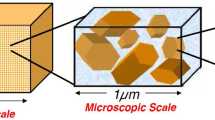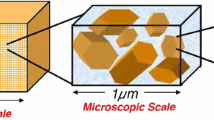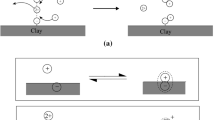Abstract
We develop a new multiscale model to compute effective properties such as relative permeability, contact angle and partition coefficients in low salinity enhanced oil recovery processes for two-phase flow in sandstones containing reactive surfaces of kaolinite clay. In this setting, we construct a three-scale approach which entails the local nanoscale description ruled by the electro-chemistry of a confined electrolyte solution containing Na+, \(Ca^{2+}\), \(H^+\), \(Cl^-\) and \(OH^-\) ions residing between bounded crude-oil droplets at residual saturation and clay substrate. Our analysis focuses on the case of surface complexation geochemical reactions between the ionic species of the invading water and the electrically charged kaolinite and oil–water interfaces. In this scenario, we construct a local electric double layer problem for the electric potential based on a non-symmetric Poisson–Boltzmann equation supplemented by nonlinear boundary conditions with the magnitude of the surface charge strongly dictated by the geochemical reactions. By invoking the local mechanical equilibrium of the electrolyte solution and solving numerically the nonlinear problem using the finite element method, we compute the local ionic profiles and reconstruct numerically the disjoining pressure and adsorption isotherms for each ionic species for a wide range of brine compositions and pH of the water phase. Furthermore, combining the disjoining pressure results with the Frumkin/Derjaguin wetting theory allows to compute the dependence of the contact angle on wettability, pH and salinity. Subsequently, the formal homogenization procedure is adopted to upscale the pore-scale flow and ion transport to the macroscale giving rise to a new Darcy scale coupled flow/transport model. The hyperbolic part of the nonlinear homogenized model is solved analytically in an 1D example of enhanced oil recovery.























Similar content being viewed by others
Abbreviations
- \(C_{ib}\) :
-
Ionic bulk concentrations for \(i=\{Na^+, Cl^-, H^+, OH^-, Ca^{2+}\}\) \((\rm {mol/m)}^3\)
- \(D_i\) :
-
Water–ion diffusion coefficients for \(i=\{Na^+, Cl^-, H^+, OH^-, Ca^{2+}\}\) (m2/s)
- \(K_W\) :
-
Ionic product of water \({\rm {(mol/m}}^3)^2\)
- \(S_w, S_o\) :
-
Water and oil saturations
- t :
-
Characteristic time scale (s)
- \(\Omega _M\) :
-
Microscopic domain
- \(\Omega _f,\Omega _s\) :
-
Fluid and solid microscopic subdomains
- \(\mathbf{V}_{w},\mathbf{V}_{o}\) :
-
Water and oil microscopic Darcy’s law (m/s)
- K :
-
Microscopic permeability (\(m^2\)).
- \(K_{rw},K_{ro}\) :
-
Water and oil relative permeabilities
- \(P_{w},P_{o}\) :
-
Water and oil pressures (Pa)
- \(\mu _{w},\mu _{o}\) :
-
Water and oil viscosities \((Pa\times s)\)
- \(P_c\) :
-
Capillary pressure (Pa).
- \({\overline{\phi }}\), \(\phi\) :
-
Dimensionless streaming potential and microscopic streaming potential (V)
- \({\mathbf {I}}_{f}\) :
-
Electric current (C/m2/s)
- \({\tilde{\mathbf {J}}}_{i}\) :
-
Total convective/diffusive ionic flux for \(i=\{Na^+, Cl^-, H^+, OH^-, Ca^{2+}\}\) (\({\rm {mol/m}}^2/s\))
- \(z_i\) :
-
Ion valence for \(i=\{Na^+, Cl^-, H^+, OH^-, Ca^{2+}\}\)
- \(\partial \Omega ^{N}_c, \partial \Omega ^{N}_o\) :
-
Nanoscopic water/clay and water/oil interfaces
- AlO, SiO :
-
Aluminol and silanol groups at clay particles
- \(COO^-, N\) :
-
Carboxylic and nitrogen groups at oil droplets
- \(\Gamma ^{AlO}_{max}, \Gamma ^{SiO}_{max}\) :
-
Maximum surface densities for aluminol and silanol groups \({\rm {(mol/m}}^2)\)
- \(\Gamma ^{COO}_{max}, \Gamma ^{N}_{max}\) :
-
Maximum surface densities for carboxylic and nitrogen groups (\({\rm {mol/m}}^2\))
- \(\sigma ^{clay}, \sigma ^{oil}\) :
-
Clay and oil surface charge densities (\(C/m^2\))
- \({\overline{C}}_{j}\) :
-
Dimensionless surface concentration of each species at the clay and oil surfaces
- \(\gamma _{j}\) :
-
Surface concentration of each reagent/product on the clay and oil surfaces (\({\rm {mol/m}}^2\))
- \(K_1, K_2, K_3\) :
-
Equilibrium constants for the reactions on the clay surface (\({\rm {mol/m}}^3\))
- \(K_4, K_5\) :
-
Dimensionless equilibrium constants for the reactions on the clay surface
- \(K_7\) :
-
Dimensionless equilibrium constants for the reactions on the oil surface
- \(K_6, K_8\) :
-
Equilibrium constants for the reactions on the clay surface (\({\rm {mol/m}}^3\))
- \(C_{i0}\) :
-
Ionic concentrations at the clay and oil surfaces (\({\rm {mol/m}}^3\))
- \(\Omega ^f_{N}\) :
-
Water phase in nanoscopic domain
- \(\Psi\) :
-
EDL electric potential (V)
- \(\varvec{E}\) :
-
EDL electric field (V/m)
- \(\tilde{\epsilon _{0}}, {\tilde{\epsilon }}\) :
-
Dielectric constant of the solvent and vacuum permittivity (C/V/m)
- q :
-
EDL volumetric charge density (\(C/m^3\))
- \(C_i\) :
-
Ionic concentrations in the EDL for \(i=\{Na^+, Cl^-, H^+, OH^-, Ca^{2+}\}\) \({\rm {(mol/m}}^3)\)
- \(C_b\) :
-
Total concentration of cations (or anions) in the bulk solution \({\rm {(mol/m}}^3)\)
- \(\mathbf{n }\) :
-
Unitary normal vector
- \(\Gamma _{i}\) :
-
Ions adsorption/desorption in the EDL for \(i=\{Na^+, Cl^-, H^+, OH^-, Ca^{2+}\}\) \({\rm {(mol/m}}^2)\)
- \(\gamma ^{clay}_{H^+}\), \(\gamma ^{oil}_{H^+}\) :
-
\(H^+\) adsorption on the clay and oil surfaces \({\rm {(mol/m}}^2)\)
- \(\gamma ^{clay}_{Ca^{2+}}\), \(\gamma ^{oil}_{Ca^{2+}}\) :
-
\(Ca^{2+}\) adsorption on the clay and oil surfaces \({\rm {(mol/m}}^2)\)
- \(p_b\) :
-
Pressure of the bulk solution (Pa)
- \(\pi\) :
-
Osmotic pressure (Pa)
- \(\varvec{\sigma }_{f}\) :
-
Cauchy stress tensor (Pa)
- \(\varvec{\tau _{M}}\) :
-
Maxwell stress tensor (Pa)
- \(\nabla _{{\mathbf {x}}}, \nabla _{{\mathbf {y}}}\) :
-
Differential operators
- Pe, Da :
-
Péclet and Dankholer numbers
- \(\alpha _{i}\) :
-
Total adsorption of each ionic species for \(i=\{Na^+,H^+,Ca^{2+}\}\) (\({\rm {mol/m}}^2\))
- \({\varvec{I}}\) :
-
Unit tensor
- \({<}\chi{>}, {<}\chi {>}_{\partial Y}\) :
-
Mean and volumetric surface average operators
- \(\varphi _f\) :
-
Porosity of the sandstone
- \(A_V^c\) :
-
Volumetric reactive surface area (\(m^{-1}\))
- \(\mathbf{V}_W^0, \mathbf{V}_O^0\) :
-
Water and oil macroscopic Darcy’s law (m/s)
- \({\varvec{K}}\) :
-
Effective permeability (\(m^2\))
- \({\varvec{\tau }}\) :
-
Tensorial characteristic function (tortuosity effects)
- \(\Pi ^{EDL}_{d}\) :
-
Normal EDL component of disjoining pressure (Pa)
- \(\Pi ^{VDW}_{d}\) :
-
Van der Waals component of disjoining pressure (Pa)
- \(\Pi ^{S}_{d}\) :
-
Short-range solvation component of disjoining pressure (Pa)
- \(\sigma ^{ow}_{\infty }\) :
-
Oil/water surface tension (Pa)
References
Adibhatla, B., Mohanty, K.K.: Parametric analysis of surfactant-aided imbibition in fractured carbonates. J. Colloid Interface Sci. 317, 513–522 (2008)
Adibhatla, B., Sun, X., Mohanty, K.K.: Numerical Studies of Oil Production from Initially Oil-Wet Fracture Blocks by Surfactant Brine Imbibition, SPE-97687, SPE International Improved Oil Recovery Conference in Asia Pacific, Kuala Lumpur, Malaysia, 5-6 December (2005)
Anderson, G.A.: Wettability literature survey- Part 1: Rock/Oil/Brine interactions and the effects of core handling on wettability, SPE-13932. J. Pet. Technol. 38(10), 1125–1144 (1986)
Anderson, W.G.: Wettability literature survey—Part 4: the effect of wettability on capillary pressure. J. Pet. Technol. 39(10), 1283–1300 (1987)
Auriault, J.L.: Heterogeneous media: is an equivalent homogeneous description always possible. Int. J. Eng. Sci. 29, 785–795 (1991)
Auriault, J.L., Adler, P.M.: Taylor dispersion in porous media: analysis by multiple scale expansions. Adv. Water Res. 18(4), 217–226 (1995)
Auriault, J.L., Lewandowska, J.: Diffusion/Adsorption/Advection macrotransport in soils. Eur. J. Mech. 15(4), 681–704 (1996)
Austad, T., RezaeiDoust, A., Puntervold, T.: Chemical mechanism of low salinity water flooding in sandstone reservoir, SPE 129767, SPE Improved Oil Recovery Symposium held in Tulsa, Oklahoma, USA, 24–28 (2010)
Basu, S., Sharma, M.M.: Measurement of critical disjoining pressure for dewetting of solid surfaces. J. Colloid Interface Sci. 181, 443–455 (1996)
Brady, P.V., Morrow, N.R., Fogden, A., Deniz, V., Loahardjo, N.: Winoto, electrostatics and the low salinity effect in sandstone reservoirs. Energy Fuels 29(2), 666–677 (2015)
Brooks, R.H., Corey, A.T.: Hydraulic Properties of Porous Media. Hydrology Papers, Colorado State University, N. 3, (1964)
Buckley, J.S., Bousseau, C., Liu, Y.: Wetting alteration by brine and crude oil: from contact angles to cores. SPE J. 1(3), 341–350 (1996)
Buckley, J.S., Liu, Y., Monsterleet, S.: Mechanism of wetting alteration by crude oils. SPE J. 3(1), 54–61 (1998)
Chen, Z., Huan, G., Ma, Y.: Computational Methods for Multiphase Flows In Porous Media. Siam, Bangkok (2006)
Churaev, N.V., Sobolev, V.D.: Prediction of contact angles on the basis of the Frumkin-Derjaguin approach. Adv. Colloid Interface Sci. 61, 1–16 (1995)
Corey, A.T.: Measurement of water and air permeability in unsaturated soil. Soil Science, Society of America Proceedings, 21, N. 1, (1957)
Davit, Y., Quintard, M.: One-phase and two-phase flow in highly permeable porous media. Heat Transf. Eng. 40(5–6), 391–409 (2019)
Denaro, A.R.: Elementary Electrochemistry, 2nd edn. Butterworth & Co Publishers, Oxford (1971)
Denbigh, K.: The Principles of Chemical Equilibrium, 4th edn. Cambridge University Press, Cambridge (1981)
Derjaguin, B.V., Churaev, N.V., Muller, V.M.: Surface Forces. Plenum Press, New York (1987)
Dickson, A.G., Riley, J.P.: The estimation of acid dissociation constants in seawater media from potentiometric titrations with strong base. Mar. Chem. 7, 89–99 (1979)
Drummond, C., Israelachvili, J.: Surface forces and wettability. J. Pet. Sci. Eng. 33, 123–133 (2002)
Green, D.W., Willhite, G.P.: Enhanced Oil Recovery. Society of Petroleum Engineers, Richardson (2018)
Gunstensen, A.K., Rothman, D.H., Zaleski, S., Zanetti, G.: Lattice Boltzmann model of immiscible fluids. Phys. Rev. A 43(8), 4320–4327 (1991)
Hirasaki, G.J.: Wettability: fundamentals and surface forces, SPE-17367. SPE Form. Eval. 6(2), 217–226 (1991)
Hirasaki, G.J.: Interfacial Phenomena in Petroleum Recovery. In: Morrow, N. R. (Ed.), Chap. 2, pp. 23–76. Dekker, New York (1991)
Hirasaki, G.J.: Interfacial Phenomena in Petroleum Recovery. In: Morrow, N. R. (Ed.), Chap. 3, pp. 77–99. Dekker, New York (1991)
Israelachvili, J.: Intermolecular and Surface Forces, 2nd edn. Academic Press, New York (1991)
Kuchin, I.V., Matar, O.K., Craster, R.V., Starov, V.M.: Influence of the disjoining pressure on the equilibrium interfacial profile in transition zone between a thin film and a capillary meniscus. Colloids Interface Sci. Commun. 1, 18–22 (2014)
Kumar, M., Fogden, A., Morrow, N.R., Buckley, J.S.: Mechanisms of improved oil recovery from sandstone by low salinity flooding. Petrophysics 52(6), 428–436 (2011)
Johansen, T., Winther, R.: The solution of the Riemann problem for a hyperbolic system of conservation laws modeling polymer flooding. JSIAM J. Math. Anal. SIAM 19(3), 541–566 (1988)
Lager, A., Webb, K.J., Collins, I.R., Richmond, D.M.: LoSal Enhanced Oil Recovery: Evidence of Enhanced Oil Recovery at the Reservoir Scale, SPE 113976, Society of Petroleum Engineers, SPE Symposium on Improved Oil Recovery, Tulsa, Oklahoma, USA, 20–23 (April 2008)
Lager, A., Webb, K.J., Black, C.J.J., Singleton, M., Sorbie, K.S.: Low salinity oil recovery—an experimental investigation. Petrophysics 49(1), 28–35 (2008)
Lake, L.W., Johns, R.T., Rossen, W.R., Pope, G.A.: Fundamentals of Enhanced Oil Recovery. Society of Petroleum Engineers, Richardson (2014)
Landau, L.D., Lifshitz, E.M.: Electrodynamics of Continuous Media. Pergamon Press, Oxford (1960)
Lima, S.A., Murad, M.A., Moyne, C., Stemmelen, D.: A three-scale model of ph-dependent flows and ion transport with equilibrium adsorption in Kaolinite Clays: I. Homog. Anal. Transp. Porous Media 85, 23–44 (2010)
Lima, S.A., Murad, M.A., Moyne, C., Stemmelen, D., Boutin, C.: A three-scale model of pH-dependent flows and ion transport with equilibrium adsorption in Kaolinite Clays: II effective-medium behavior. Transp. Porous Media 85, 45–78 (2010)
Liu, Y., Buckley, J.S.: Some mechanisms of crude oil/brine/solid interactions. J. Pet. Sci. Eng. 20(3–4), 155–160 (1998)
Liu, Y., Buckley, J.S.: Mechanisms of wetting alteration by crude oils, SPE-37230. SPE J. J. Pet. Sci. Eng. 3(1), 54–61 (1998)
Moqadam, M.S., Riahi, S., Bahramian, A.: An investigation into the electrical behavior of oil/water/reservoir rock interfaces: The implication for improvement in wettability prediction, Colloids and Surfaces A: Physicochem. Eng. Aspects 490, 268–282 (2016)
Morrow, N.R., Tang, G.-Q., Valat, M., Xie, X.: Prospects of improved oil recovery related to wettability and brine composition. J. Pet. Sci. Eng. 20(3–4), 267–276 (1998)
Morrow, N.R.: Wettability and its effect on oil recovery, SPE-21621. J. Pet. Technol. 42(12), 267–276 (1990)
Moyne, C., Murad, M.A.: Electro-chemico-mechanical couplings in swelling clays derived from a micro/macro homogenization procedure. Int. J. Solids Struct. g. 39, 6159–6190 (2002)
Murad, M.A., Moyne, C.: A dual-porosity model for ionic solute transport in expansive clays. Comput. Geosci. 12, 47–82 (2007)
Newman, J.S.: Electrochemical systems. Prentice-Hall Inc, Englewood Cliffs (1973)
Nikolov, A., Wasan, D.: Wetting—dewetting films: the role of structural forces. J. Adv. Colloid Interface Sci. 206, 207–221 (2014)
Bedrikovetsky, P.: Mathematical Theory of Oil and Gas Recovery with Applications to ex-USSR Oil and Gas Fields, Petroleum Engineering and Development Studies, vol. 4. Springer, Berlin (1993)
Picchi, D., Battiato, I.: The impact of pore-scale flow regimes on upscaling of immiscible two-phase flow in porous media. Water Resour. Res. 54, 6683–6707 (2018)
Pope, G.: The application of fractional flow theory to enhanced oil recovery. Soc. Pet. Eng. J. 20(3), 191–205 (1980)
Praunitz, J.M., Lichtenthaler, R.N., Azevedo, E.G.: Molecular Thermodynamics of Fluid-Phase Equlibria, 3rd edn. Prentice Hall, Upper Saddle River (1999)
Ponce, R.V.F., Murad, M.A., Lima, S.A.: A two-scale computational model of pH-sensitive expansive porous media. J. Appl. Mech. 80, 020903-1–020903-14 (2013)
RezaeiDoust, A., Puntervold, T., Strand, S., Austad, T.: Smart water as wettability modifier in carbonate and sandstone: a discussion of similarities/differences in the chemical mechanisms. Energy Fuels 23(9), 4479–4485 (2009)
Sanchez-Palencia, E.: Non-homogeneous Media and Vibration Theory. Springer, Berlin (1980)
Sasidhar, V., Ruckenstein, E.: Electrolyte osmosis through capillaries. J. Colloids Interface Sci. 82(2), 439–457 (1981)
Sheng, J.: Enhanced Oil Recovery Field Case Studies, 1st edn. Gulf Professional Publishing, Burlington (2013)
Sheng, J.: Modern Chemical Enhanced Oil Recovery: Theory and Practice, 1st edn. Gulf Professional Publishing, Burlington (2010)
Stumm, W., Morgan, J.J.: Aquatic Chemistry: Chemical Equilibria and Rates in Natural Waters, 3rd edn, pp. 103–104. Wiley, New York (1996)
Tang, G., Morrow, N.R.: Influence of brine composition and fines migration on crude oil/brine/rock interactions and oil recovery. J. Pet. Sci. Eng. 24(2–4), 99–111 (1999)
Tang, G., Morrow, N.R.: Salinity, temperature, oil composition, and oil recovery by waterflooding, SPE-36680. Soc. Pet. Eng. SPE Reserv. Eng. 12(4), 269–276 (1997)
van Olphen, H.: An Introduction to Clay Colloid Chemistry: for Clay Technologists, Geologists, and Soil Scientists. Wiley, New York (1977)
Xie, Q., Sari, A., Pu, W., Chen, Y., Brady, P.V., Al Maskari, N., Saeedi, A.: pH effect on wettability of oil/brine/carbonate system: implications for low salinity water flooding. J. Pet. Sci. Eng. 168, 419–425 (2018)
Yildiz, H.O., Morrow, N.R.: Effect of brine composition on recovery of moutray crude oil by waterflooding. J. Pet. Sci. Eng. 14(3–4), 159–168 (1996)
Zhang, Y., Xie, X., Morrow, N.R.: Waterflood Performance by Injection of Brine With Different Salinity for Reservoir Cores, SPE 109849, Society of Petroleum Engineers.In: SPE Annual Technical Conference and Exhibition, Anaheim, California, U.S.A., 11–14 (2007)
Author information
Authors and Affiliations
Corresponding author
Additional information
Publisher's Note
Springer Nature remains neutral with regard to jurisdictional claims in published maps and institutional affiliations.
Appendices
A. Dependence of the retardation coefficient on clay content
In what follows, we develop a direct relation between the clay volumetric surface area \(A^c_V\), specific surface area \(A_S^c\) and the clay content CC.
Denoting \(M_c\) and \(M_s\) the mass of the clay and sandstone, \(\rho _c\) and \(\rho _s\) the corresponding densities we have by definition
where \(|Y_c|\) and \(|Y_s|\) are the volumes occupied by the clay and sandstone matter, respectively. The clay specific surface area \(A_S^c\) and the clay content CC are defined by
where \(A^{c}\) is the surface area of the clay particles in the domain.
Thus denoting \(|Y_f|\), \(|Y_c|\) and \(|Y_s|\) the volume occupied by the interparticle pores, clay and sandstone, respectively, with \(|Y| =|Y_f|+|Y_c|+|Y_s|\). We have
where \(\varphi _f\), \(\varphi _c\) \(\varphi _s\) are the volume fractions of the interparticle pores, clay and inorganic matter, respectively. Using the definition (126)–(128) the volumetric surface area of the clay \(A^c_V\) can be expressed in the form
Also
From the definitions (126)–(127), the expressions \(|Y_s|/|Y_c|\) above can be rewritten in the form
In Fig.24 we display the volumetric surface area (\(A^c_V\)) as a function of clay content (CC) for three different specific surface areas (\(A^c_S\)). For the (Fig. 24a and b), we consider \(\varphi =0.5\) and 0.75, respectively. The results show that the volumetric surface area increase linearly with the clay content and specific surface area. Moreover, the increase of the porosity decreases the \(A^c_V\).
B. Contact Angle
Here, we revise the Frumkin/Derjaguin stability theory which establishes the correlation between the contact angle of an oil droplet on a substrate and local balance between capillary and disjoining pressures. Thus, \(P_c\) denoting the capillary pressure, defined by the pressure difference between non-wetting and wetting phases, the modified Young–Laplace equation is given by Basu and Sharma (1996), Hirasaki (1991)
where \(\sigma ^{w,nw}\) is the interfacial tension between wetting and the non-wetting phases and J is the surface curvature of the oil droplet.
The film tension \(\sigma ^{f}\) of the aqueous electrolyte solution is given by
with \(\sigma ^{ow}\) and \(\sigma ^{sw}\) the surface tensions at the aqueous/oil and aqueous/clay interfaces, respectively.
For a fixed temperature T and chemical potential \(\mu\), the thermodynamic definition of the total disjoining pressure is given by Basu and Sharma (1996), Hirasaki (1991a), Hirasaki (1991b)
Hence, integrating the above expression from the flat region where \(J=0\) and \(H=H(P_c)\) to \(H\rightarrow \infty\) gives
where \(\sigma ^{ow}_{\infty }\) and \(\sigma ^{sw}_{\infty }\) denote the tension in the bulk fluid. Now combining (134) and (136) furnishes
The contact angle can be computed from Young equation in the form
Thus, using (138) in (137) we derive the representation for the contact angle in terms of the disjoining pressure
where in the flat region \(J=0\) using (133) we have
Finally, combining (139) and (140) we arrive at the desired representation for the contact angle
Rights and permissions
About this article
Cite this article
Lima, S.A., Murad, M.A., Vicente, B.J. et al. A New Multiscale Computational Model for Low Salinity Waterflooding in Clay Bearing Sandstones. Transp Porous Med 135, 361–408 (2020). https://doi.org/10.1007/s11242-020-01480-3
Received:
Accepted:
Published:
Issue Date:
DOI: https://doi.org/10.1007/s11242-020-01480-3





